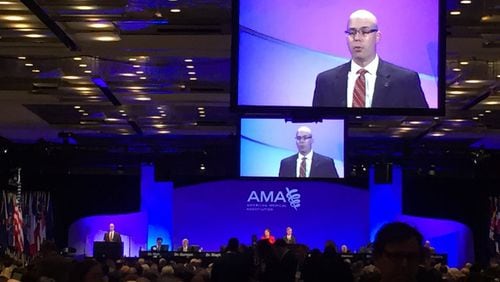The American Medical Association will no longer tolerate sexual misconduct by physicians – at least if their victims are other doctors, and if the abuse occurs at an AMA event.
But the association is doing nothing to crack down on predators who violate other victims: their patients.
The AMA, the nation's largest and most influential medical society, convenes its annual meeting Saturday in Chicago. Delegates will talk about insurance coverage for compression stockings. They'll debate discarding the phrase "gun control" in favor of "gun violence mitigation." They'll consider the stigma of obesity, the dangers of liquid laundry-soap packets, and the unpleasantness of hospital food.
But almost a year after The Atlanta Journal-Constitution revealed widespread sexual misconduct in the medical profession, the AMA has scheduled neither formal proposals nor public discussions on doctors who abuse their patients.
The organization’s silence forfeits an opportunity to address a problem that has stirred public interest, patient advocates and medical ethicists say.
"They seem more likely to address someone else's problems than their own," said Lisa McGiffert, manager of the Safe Patient Project for the advocacy group Consumers Union. "They're real masters at deflecting responsibility."
Arthur Caplan, a bioethicist at New York University Langone Medical Center, said the AMA deserves credit for targeting bad behavior at its events.
But “it should be the start of the AMA engaging on the broader issue” of sexual misconduct in examination rooms and hospital wards, Caplan said. “We expect character and virtue from our physicians.”
Society grants special privileges to doctors, he said – not least, the intimacy of physical examinations.
“Doctors are held to a higher standard,” Caplan said, “and rightly so.”
The AMA declined to make officials available for an interview. The association released a statement from Dr. Patrice A. Harris, a psychiatrist from Atlanta who chairs the AMA's board of trustees. It quoted Harris as saying the AMA has "zero tolerance for discrimination and harassment in any form."
“The medical profession must represent the highest ethical standards, and we take allegations of misconduct seriously,” Harris’ statement said. “The AMA has for many years had a comprehensive anti-harassment policy in place for AMA employees. As part of the AMA’s ongoing commitment to respectful and professional conduct in all settings, the proposed new policy would extend beyond the walls of AMA buildings to cover all locations where AMA is convening to conduct business.”
A silent voice
The association has not publicly addressed sexual misconduct since the Journal-Constitution published its “Doctors & Sex Abuse” series last year. Stories in the series documented a professional culture that has tolerated and even covered up abuse for decades.
The newspaper identified more than 2,400 doctors who had been disciplined for sexual violations involving patients; half are still licensed to practice medicine.
But the numbers fail to capture the scope of misconduct. Many state medical boards deal with sex cases in private and issue no public findings. Others use vague language or euphemisms to hide the true nature of disciplinary matters. By some estimates, 7 percent of American doctors have engaged in sexual misconduct – meaning that tens of thousands may have engaged in harassment, molestation, even rape.
The AMA plays no direct role in licensing or disciplining doctors, a function of state medical authorities. But the association is a powerful voice for the medical profession, not to mention one of the most influential lobbies in Washington and in state capitals. Its reticence on sexual misconduct could enable regulators to downplay the prevalence and seriousness of such offenses.
“The AMA is a leader in this country for doctors,” McGiffert said. “It seems appropriate they should have strong policies and guidelines on sexual misconduct by doctors.”
AMA delegates first addressed sexual misconduct in 1989, when they adopted a resolution that described most sexual contact between doctors and patients as a breach of medical ethics. But that resolution focused on consensual sex in purportedly romantic relationships. It did not contemplate more sinister offenses such as physical assaults during medical procedures.
Why the AMA’s board of trustees is bringing forth the latest proposal is not clear.
The trustees released a report saying they “recently became aware” that the AMA lacked an anti-harassment policy covering its members attending the association’s events. AMA rules already protected the association’s employees at official functions.
By far the best attended of those functions is the annual meeting of the House of Delegates, the AMA's governing body. Thousands of doctors and medical students, including about 1,000 delegates and alternates, congregate in a giant convention hotel a few blocks from the AMA's headquarters in downtown Chicago. About three-fourths of the attendees are men, according to a recent AMA report.
Sessions run from morning to late afternoon, and formal and informal social events – receptions staged by candidates for president of the AMA or dinners and parties honoring state delegations and medical specialties – fill the evenings. The 2016 meeting even included a political fundraiser for then-U.S. Rep. Tom Price, the Georgia Republican who has since become secretary of the U.S. Department of Health and Human Services.
Any debauchery last year apparently took place outside public view, or at least away from reporters who attended the meeting.
But McGiffert said the trustees’ report suggests AMA officials have received complaints of misconduct.
“It makes me wonder if some kind of incident occurred,” she said. “That is highly damning in itself.”
Language in the trustees’ report makes doctors attending AMA meetings sound like spring breakers in Daytona Beach.
Banned behavior includes “explicit sexual propositions, sexual innuendo, suggestive comments or gestures, descriptive comments about an individual’s physical appearance, electronic stalking or lewd messages, displays of foul or obscene printed or visual material, and any unwelcome physical contact.”
The 1989 policy on sexual misconduct with patients does not recommend specific penalties for violators. But the proposal regarding AMA events makes clear that punishment is certain. Doctors could be forced to leave meetings or could even be expelled from the House of Delegates.
“The AMA is committed to zero tolerance for harassing conduct at all locations where AMA delegates and staff are conducting AMA business,” the proposal says. Officials promise that investigations will be prompt and thorough – although not transparent.
“To the fullest extent possible,” the trustees’ report says, “the AMA will keep complaints and the terms of their resolution confidential.”
The AMA historically has released little information about disciplinary matters, even to its members. A report prepared for this year’s House of Delegates meeting said the association revoked the membership of 12 doctors in the past 12 months, suspended nine and placed 14 others on probation. The association issued no sanctions in 23 cases.
The report withheld not only the doctors’ names, but also their violations.
‘Difficult environment’
The sexual-harassment proposal implicitly acknowledges a problem that has long plagued medicine and other male-dominated professions: a sexist culture that permits or even encourages misbehavior targeting women.
The Journal of the American Medical Association highlighted this culture last year, reporting on a survey of more than 1,700 physicians by researchers at the University of Michigan medical school.
Thirty percent of women doctors said male colleagues had sexually harassed them. Among those women, four in 10 cited unwanted sexual advances, and almost 1 in 10 described “coercive advances.”
The results surprised the researchers, who expected the growing number of women in the medical profession to have deterred widespread harassment, said Dr. Reshma Jagsi, one of the study's authors.
About one-third of U.S. doctors are women, and medical schools have almost as many female students as male, Jagsi said in an interview.
“I would have expected those changes to already be more evident” in reducing sexual harassment, she said. “I was quite sobered.”
Jagsi considers the AMA’s proposal addressing behavior at its meetings to be a positive step. Such events are ripe for misbehavior, she said: They are overseen by a male-dominated hierarchy, participants can slip away to hotel rooms, and alcohol flows freely.
“This is a very difficult environment,” Jagsi said, “very difficult to navigate as a woman.”







